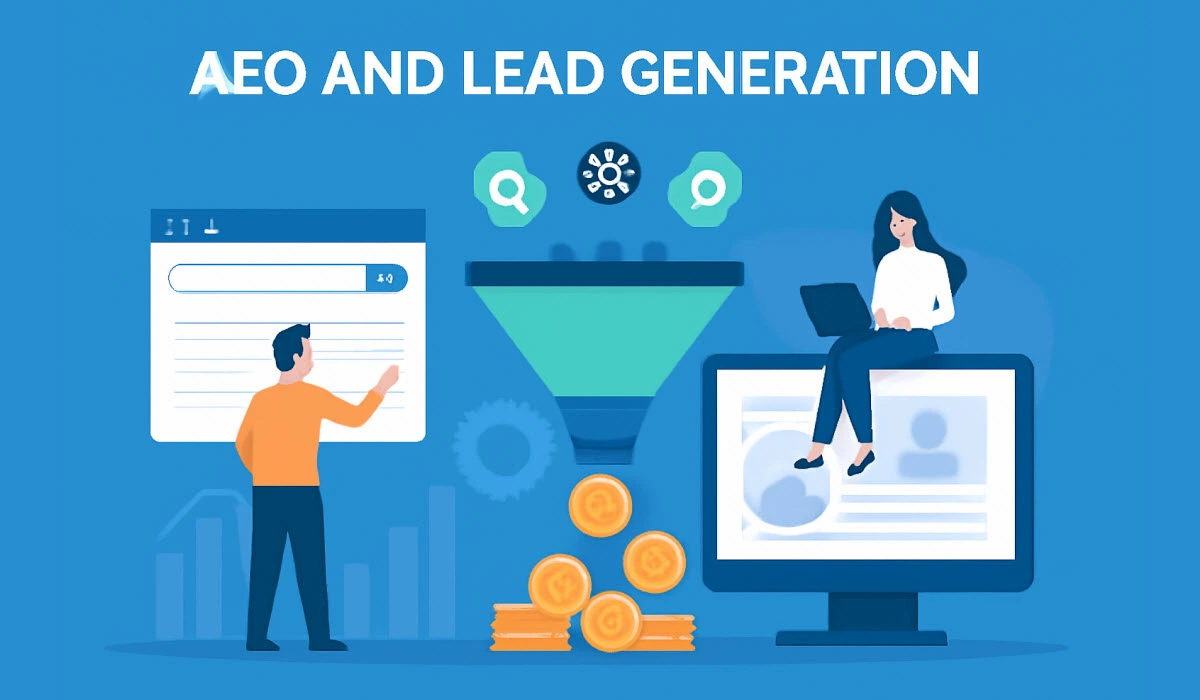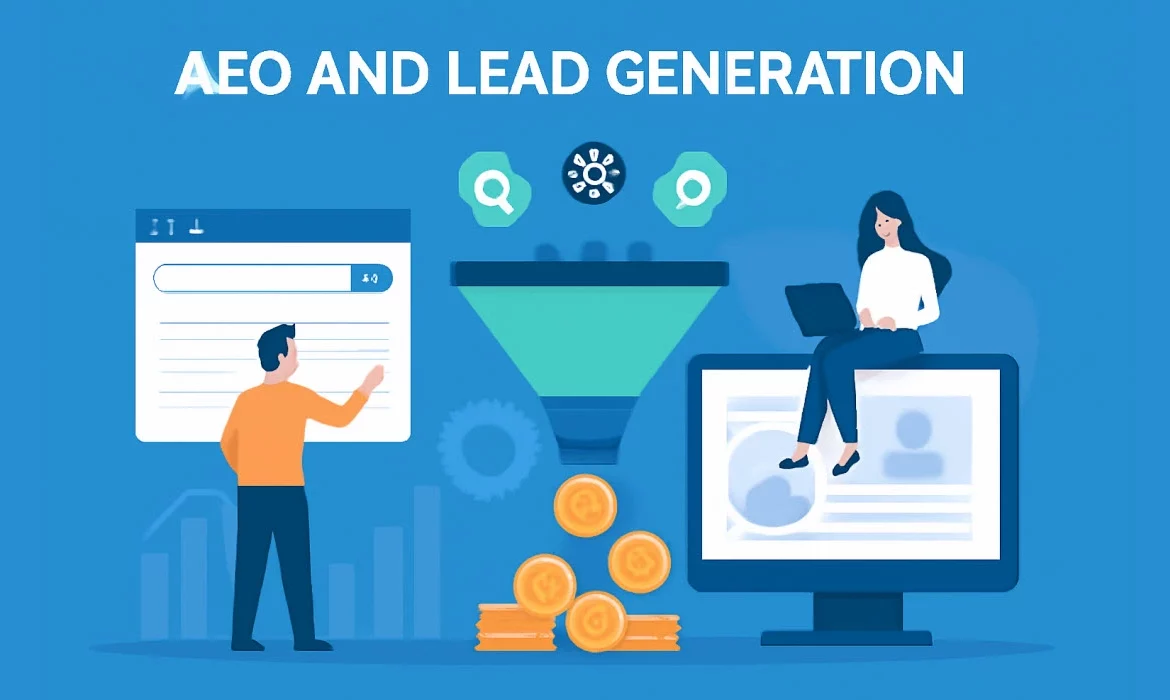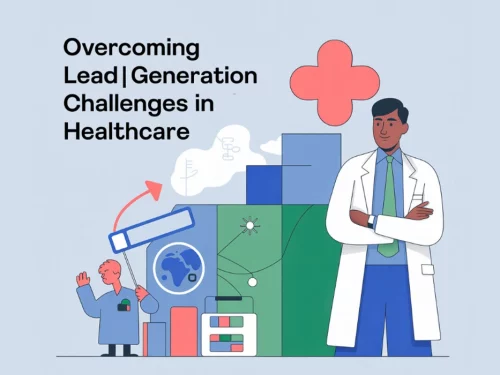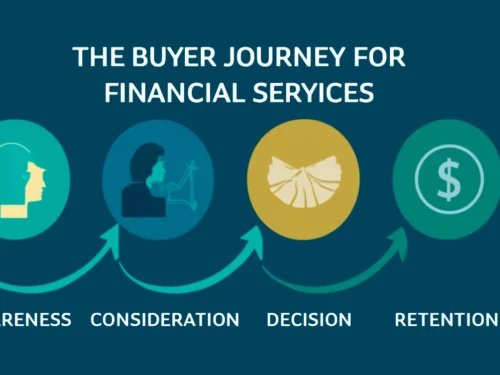
Have you recently noticed a drop in the quality of leads you’ve been getting despite all your SEO efforts? Well, you’re not alone.
In 2025, traditional SEO isn’t enough to capture the attention of today’s savvy B2B buyers. Answer Engine Optimization (AEO) is the game-changer that can elevate your lead generation.
It’s not just about ranking anymore. It’s about ensuring your content shows up directly in AI-powered search answers. If you’re missing out on optimizing for AEO, you’re leaving potential, high-intent leads on the table.
Let’s dive into how AEO can help B2B marketers capture better leads and stay competitive.
The Shift from Traditional SEO to AEO
Answer Engine Optimization (AEO) focuses on optimizing your content for AI-powered search engines, such as Google’s Search Generative Experience (SGE), and voice assistants.
Unlike traditional SEO, which aims to rank your content in search results, AEO targets getting your content directly featured in AI-generated answers, which users see instantly.
How AI Overview Changed the Game
Not too long ago, when you searched for something online, you’d see a list of search results and click through to find the information you wanted. But in 2024, over 60% of Google searches resulted in zero clicks.
Why? Because AI-driven answers are now displayed directly on the search page in the AI overview section, eliminating the need to visit websites. Users receive instant, relevant answers, marking a significant shift in how people search.
The Shift We Experienced: How We Get More Leads with AEO
At EvenDigit, we collaborated with an innovative B2B brand that offered a revolutionary product. The product is a cooking oil solidifier that helps users safely dispose of cooking oil by turning it into a solid.
For the brand, we have already established a solid SEO presence, and its pre-appearance on Shark Tank has gained significant recognition. However, despite this strong foundation, we began noticing an emerging challenge.
As AI-driven search engines like Google’s SGE and ChatGPT became more prevalent, we realized that our content needed to be in AI-generated answers or featured snippets.
We understood that if we didn’t align our content for AEO, we would miss out on authority-building opportunities, traffic, and ultimately, qualified leads. Moreover, we were allowing competitors to dominate these new search features.
To adapt, we shifted our approach:
- Content Realignment for AEO: We refocused on creating answer-driven content that directly addressed user queries in a simple, concise manner. Instead of writing broad, informational content, we began crafting solutions that were optimized for AI-driven platforms.
- Query-Based Optimization: Our content was optimized for specific long-tail queries related to our product’s use case, like “how to dispose of cooking oil safely” or “best cooking oil solidifier.” This allowed us to be featured in answer boxes and AI summaries.
- A/B Testing: We didn’t just implement the changes blindly; we rigorously tested our content’s effectiveness. Through A/B testing different formats, we found the optimal combination of concise, solution-oriented content that performed well in AI-driven searches.
The result?
Our client’s brand began appearing in Google AI Overviews and ChatGPT’s responses, resulting in a 10x increase in visibility in search.
We were able to hold our competitive edge and continue generating qualified leads by ensuring that their content was optimized not only for traditional SEO but also for the evolving AI search landscape.
Roadblocks for Search Engine Optimization Leads in 2025
With the rise of AI-powered search engines and Answer Engine Optimization (AEO), traditional SEO tactics are becoming less effective. Below are the most common roadblocks B2B businesses face today:
1. Lack of Query-Based Content
Many B2B websites still focus on broad, keyword-heavy content. However, with AI-driven search engines prioritizing specific queries, businesses that don’t focus on answering real-time, user-driven questions are missing out on valuable opportunities to appear in AI-generated answers, voice searches, and featured snippets.
2. Failure to Optimize for Voice and AI Searches
As voice search and AI-powered platforms like Google’s SGE and ChatGPT become more prevalent, B2B businesses that continue to optimize for traditional text-based searches are at a significant disadvantage.
Websites that do not cater to voice search or AI-driven queries risk losing visibility in these emerging search environments.
3. Competing for Featured Snippets
Featured snippets have become a primary focus for AI-powered search engines, but securing this coveted position has become increasingly competitive.
Websites that aren’t optimized for featured snippets risk being outranked by competitors who have mastered the art of answering specific questions directly.
4. Lagging Page Load Times and Poor User Experience
In 2025, slow-loading pages and poor user experience are significant barriers to success in AI-driven search environments. AI engines, as well as users, prioritize fast, mobile-friendly websites with clear navigation.
Websites that fail to meet these technical requirements risk being ignored by AI tools and losing valuable traffic.
5. Overlooking Schema Markup and Structured Data
Without proper schema markup, many B2B websites fail to communicate the context of their content effectively to AI engines.
Search engines and AI-powered platforms rely on structured data to understand the content better, and a lack of schema markup can prevent your content from appearing in AI summaries, voice searches, or featured snippets.
6. Lack of Clear Answer-Driven Content
B2B businesses often struggle with creating content that directly answers specific user questions. While long-form content is helpful for traditional SEO, it doesn’t always fit the needs of AI-driven search engines that prefer concise, answer-focused content.
Failing to provide clear and direct answers results in missed opportunities for appearing in AI-generated search results.
10 Strategies for Optimizing AEO for B2B Lead Generation
Here are the ten key strategies for optimizing AEO in your B2B marketing efforts. These will not only enhance your visibility on AI-driven platforms but will also help you generate more relevant leads.
1. Targeting Intent-Based Keywords
In the age of AEO and lead generation, targeting intent-based keywords is essential. Instead of focusing solely on traditional SEO, B2B companies should target long-tail and question-based keywords, such as “how to generate SEO leads” or “best strategies for [specific industry].”
These keyword phrases are ideal for appearing in AI-driven answers, increasing your chances of appearing in the coveted featured snippets and driving better leads.
2. Creating Content for AI-Driven Search Results
When structuring content for AEO and lead generation, create answers that directly address the user’s queries. Use formats like Q&A, concise paragraphs, and bullet points.
Leverage schema markup (FAQ, HowTo) to ensure search engines can easily recognize and display your content in AI-generated results. This helps your content get noticed faster and increases your chances of generating high-quality leads.
3. Optimizing for Voice Search
With the advancement of voice search, it’s essential to adapt your content for voice-driven queries. People often ask their devices, “What’s the best solution for [problem] in [industry]?”
By tailoring content to reflect natural language, you can align your answers to match how users are searching. This is particularly important for B2B search engine marketing, where precise and actionable answers are necessary to capture more leads.
4. Building Authority through AEO
AEO and lead generation go hand-in-hand by helping you establish authority in your field. When your content answers the exact questions potential customers are asking, it builds trust.
Over time, this solidifies your position as a reliable resource, making your brand a go-to option in the industry. This is crucial for B2B SEO companies seeking to dominate AI-driven search results and attract high-quality leads.
5. Leveraging AI-Driven Insights to Improve AEO Performance
AI analytics tools help refine AEO strategies by providing real-time feedback and insights. Tools like heatmaps, click tracking, and real-time user engagement data allow you to adjust your content dynamically.
Through A/B testing, you can optimize CTAs, titles, and formats to identify which variations lead to higher conversion rates. By leveraging these AI-driven insights, you can continuously improve your AEO efforts and generate more quality B2B leads.
6. Prioritize Structured Data for AEO
Incorporating structured data, such as the FAQ schema or the HowTo schema, into your content can significantly enhance its performance in AI-powered search results.
It lets search engines understand your content more effectively and present it more accurately, ensuring your responses appear in relevant AI-generated answers. This strategy is crucial for enhancing B2B search engine marketing and achieving improved visibility in voice search results.
7. Create Content Hubs to Increase Authority
Creating content hubs around specific topics allows you to build topical authority. When your content is structured in clusters around a central theme, it signals to search engines that your website is a definitive resource on that subject.
For AEO and lead generation, organizing content this way enhances your chances of getting featured in AI-driven search results.
8. Focus on Mobile Optimization
AI-driven answers are often accessed via mobile devices. Therefore, mobile optimization is crucial for both AEO and SEO success.
Ensure your content is easy to read on mobile devices, with a quick loading speed and clear navigation. This enhances user engagement and improves the performance of your content on AI-powered search platforms.
9. Optimize for Featured Snippets
Featured snippets are the prime location for AEO and lead generation. These snippets are the boxed answers that appear at the top of search results. To optimize for featured snippets, focus on clearly and concisely answering specific questions.
Structuring content with well-defined headings, lists, and bullet points will help your content appear in these prominent positions.
10. Integrating AEO with B2B SEO for Maximum Impact
Finally, integrating AEO and SEO is crucial for maximizing lead generation. By combining the power of AEO and traditional SEO, B2B businesses can increase visibility across both AI-driven platforms and traditional search engines.
Using schema markup, creating content hubs, and focusing on both SEO and AEO strategies together will help your content rank well in both realms.
Stay Ahead with AEO – The Key to Driving Quality B2B Leads
As AI continues to evolve, adapting your website to meet these changes is crucial for staying ahead in the competitive B2B landscape. The search trends shift daily, and to remain relevant, you need to optimize your content for AI-driven platforms that prioritize Answer Engine Optimization (AEO).
Today, simply writing content is not enough. Your content must be AEO-compatible, making sure that answer engines see your brand as an authority and source for relevant, high-quality answers.
At EvenDigit, we understand the intricacies of both SEO and AEO. Our team of SEO strategists and content writers specializes in crafting AEO-optimized content that resonates with both AI-driven search engines and human users.
We’ll help you skyrocket your B2B lead generation with expert-level strategies and execution.
Don’t let your business miss out on the opportunities AEO offers. Let’s connect today and start boosting your lead generation strategy with tailored, AEO-friendly SEO that stands out in this AI-powered era.




